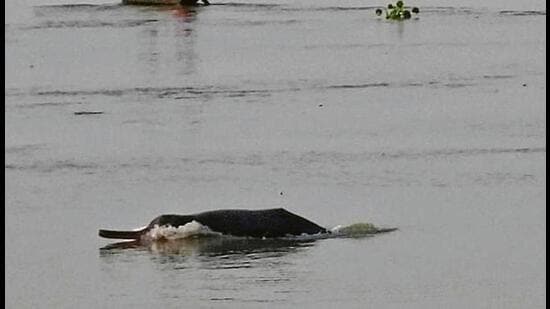Gangetic dolphins return, spawn abundant hope in Varanasi village
Dhakwa village in Varanasi is perhaps one of the few points in eastern Uttar Pradesh where Gangetic dolphins can be spotted in large numbers
The sheer magic of Gangetic dolphins surfacing in the river at Dhakwa village in abundance on the Varanasi-Ghazipur border puts a smile on the face of Nagendra Kumar Nishad, a wildlife activist.

“See those small ones in the middle are calves and the ones circling around are the grown ones. They are very protective like humans,” says Nishad, who is also a resident of the village, which now has a dolphin sighting point.
Dhakwa, locally known as Dhaka, is the village nearest to the confluence of the Ganga and Gomti rivers, about 30 kilometres from Varanasi city.
It is perhaps the lone point in the entire east U.P. where dolphins can be spotted in such abundance.
“It’s the confluence point where water is the purest. And it is the main reason why Gangetic dolphins that are considered to be the river pollution indicators, are in abundance here,” says Nishad.
“There was a time when dolphins used to be in abundance here. The fond memories of my childhood are still fresh when dolphins that we locally call ‘Sauns’ used to be spotted from close quarters. But over the years, dolphin sightings decreased,” recollects Nishad.
Nishad decided to delve into the reason why dolphin sightings decreased in the region and tried to make efforts to bring them back.
“In 2017, I got an opportunity to attend a workshop in Rishikesh on saving marine life, especially the endangered species, including Gangetic dolphins. I learnt a lot from there,” Nishad says.
He joined the Wildlife Institute of India (WII) and decided to work for the conservation of Gangetic dolphins.
“But making fishermen understand things about conservation of marine life was not easy. Initially, they thought that I am there to take their livelihood. I tried to make them understand but my suggestions fell on deaf ears,” he says.
He won their confidence by helping them in solving their problems, linking them to government welfare schemes and alongside make them understand the importance of Gangetic dolphins and other endangered species.
“I told them two things—first, to stop using the gillnets that are the most lethal for dolphins and second, to stop polluting the river as dolphins are the true indicators of the river (purity) and are very sensitive towards pollution,” he adds.
Gillnets, which have layers of fine nylon mesh, are the gear of choice for many small-scale fishers. The dolphins need to rise up to the water surface to breathe. The calves need to come up every 10 seconds to one minute while adult dolphins surface every three minutes to breathe. If trapped in fishing nets placed under water, the dolphins cannot emerge from the water to breathe, leading to their painful death, he explains.
He also made the villagers aware of pollution. “I told them not to use polythene, stop putting puja samagri (material) into the Ganga. I also told them not to pollute the river water by washing clothes with detergent and other chemicals.”
“I started getting support from the villagers. I gradually spread my network to 44 other villages along the Ganga in and around Varanasi,” he says.
Suman Devi, village head of Dhakwa, says, “ They have stopped using gill nets and desisted from polluting the river. If a dolphin gets stuck in their net, they make sure that they release it back into the river. It’s for this reason that the dolphins are back in Dhakwa.” Sunita Rawat, community officer with WII who works for conservation of aquatic life in an eight-km stretch of the Ganga passing through Varanasi, says, “The number of dolphins in the region is on the rise. It’s good to see our national aquatic animal back in Dhakwa,” Sunita Rawat says.
Arun Kumar Upadhyaya, range officer (Kashi), of the U.P. forest department says as per the latest dolphin census carried out in the first week of October 2022, more than 50 dolphins have been spotted in Dhakwa and Kaithi. During a census exercise carried out in 2021, the number of Gangetic dolphins sighted at these two places was in the 30s.





